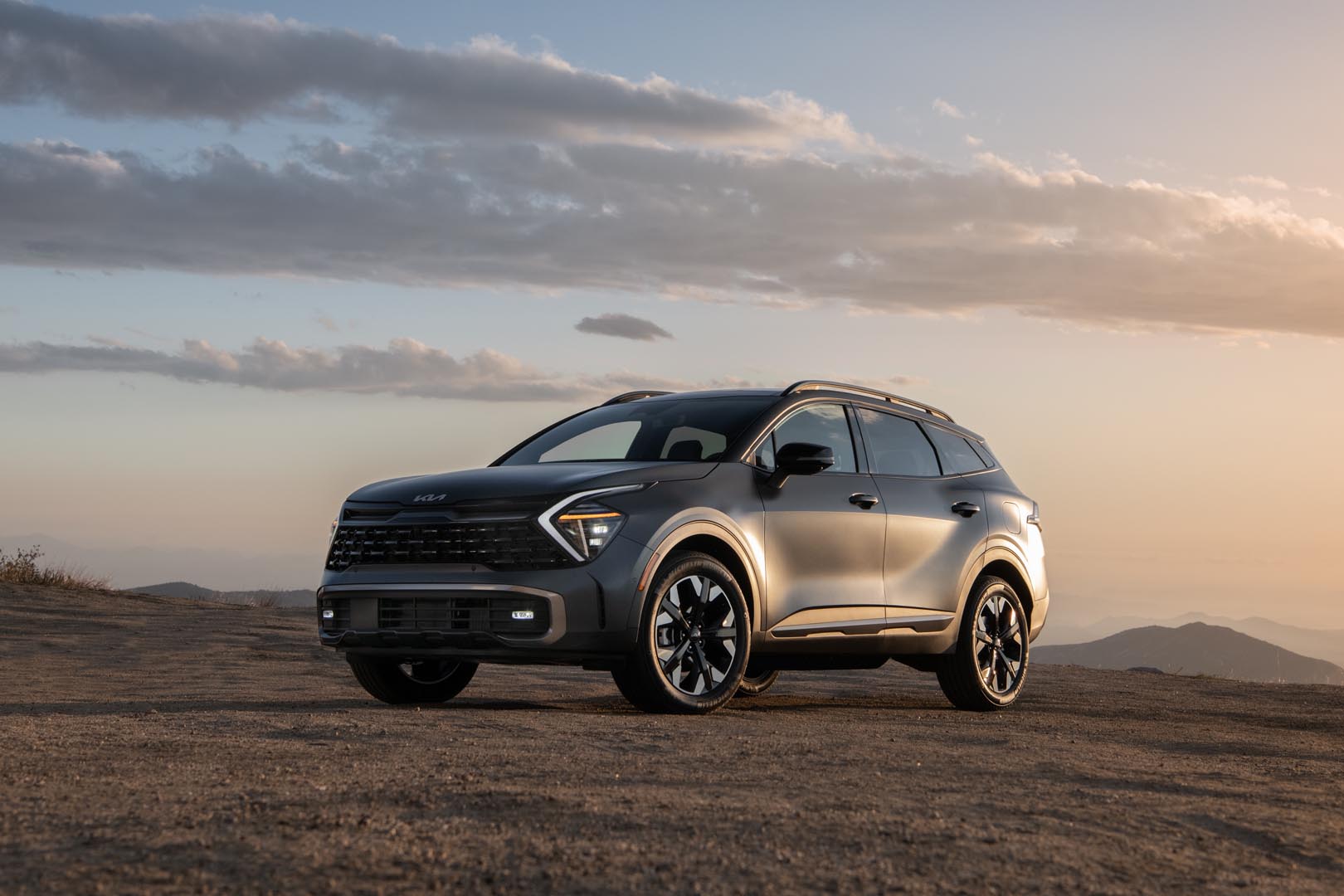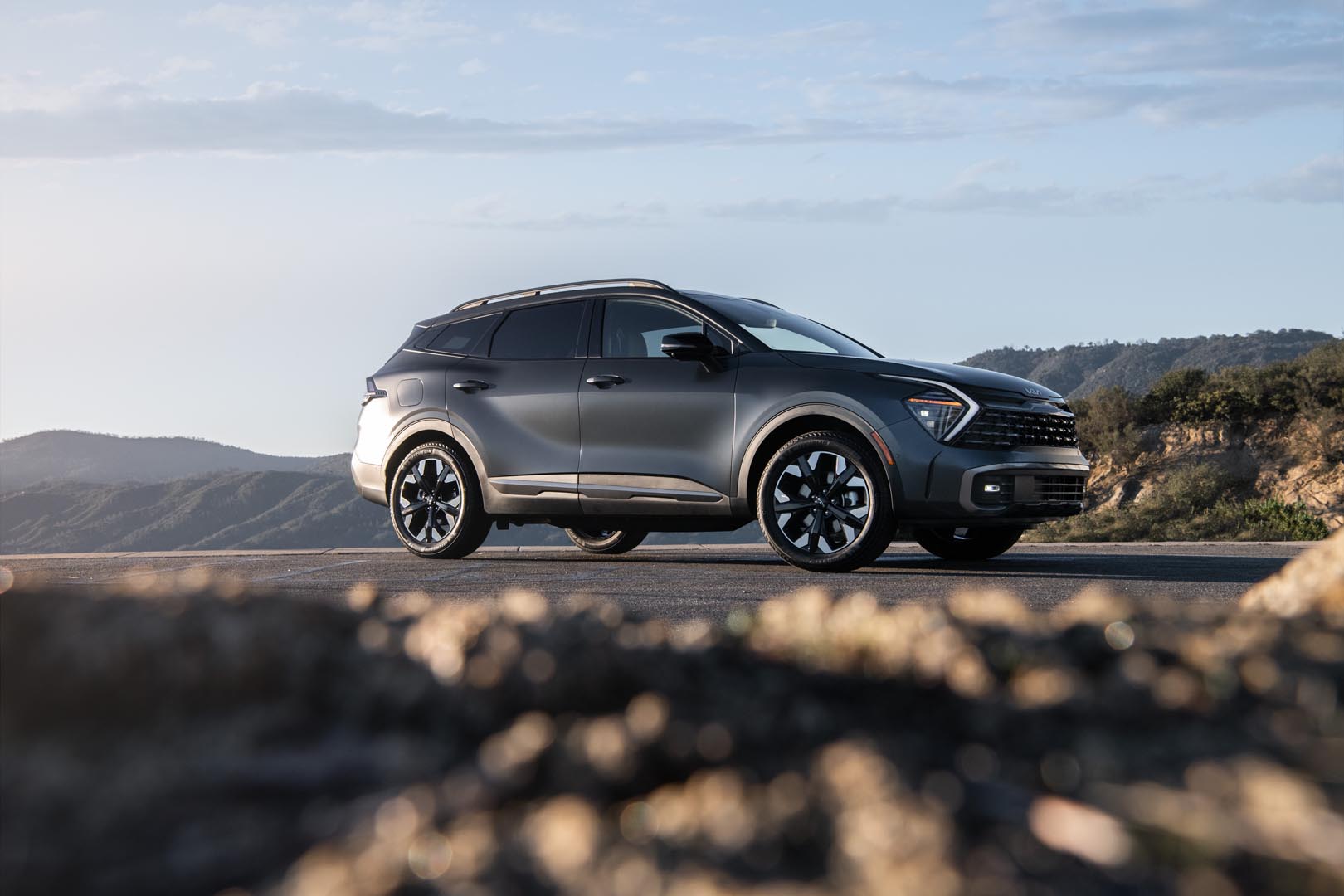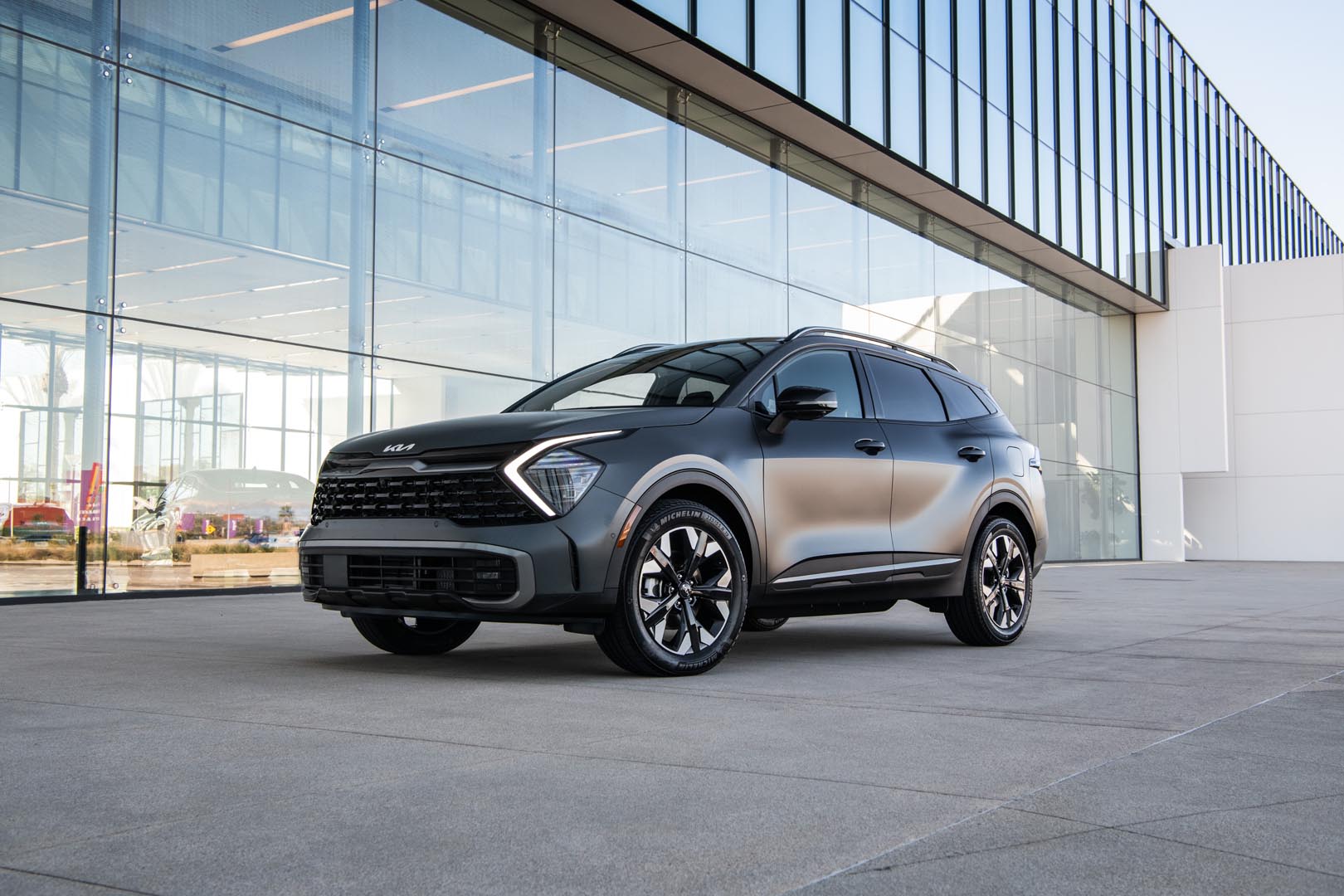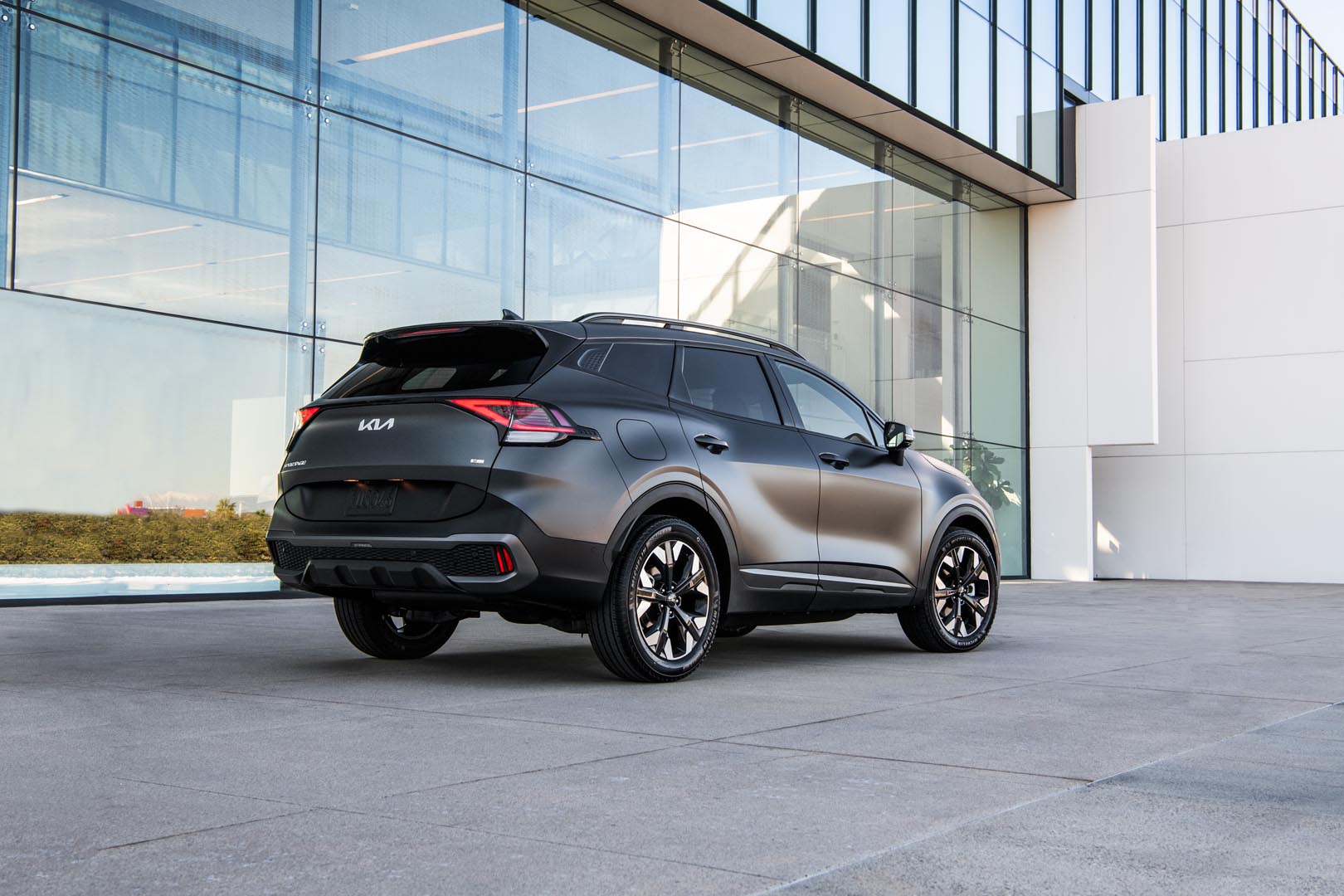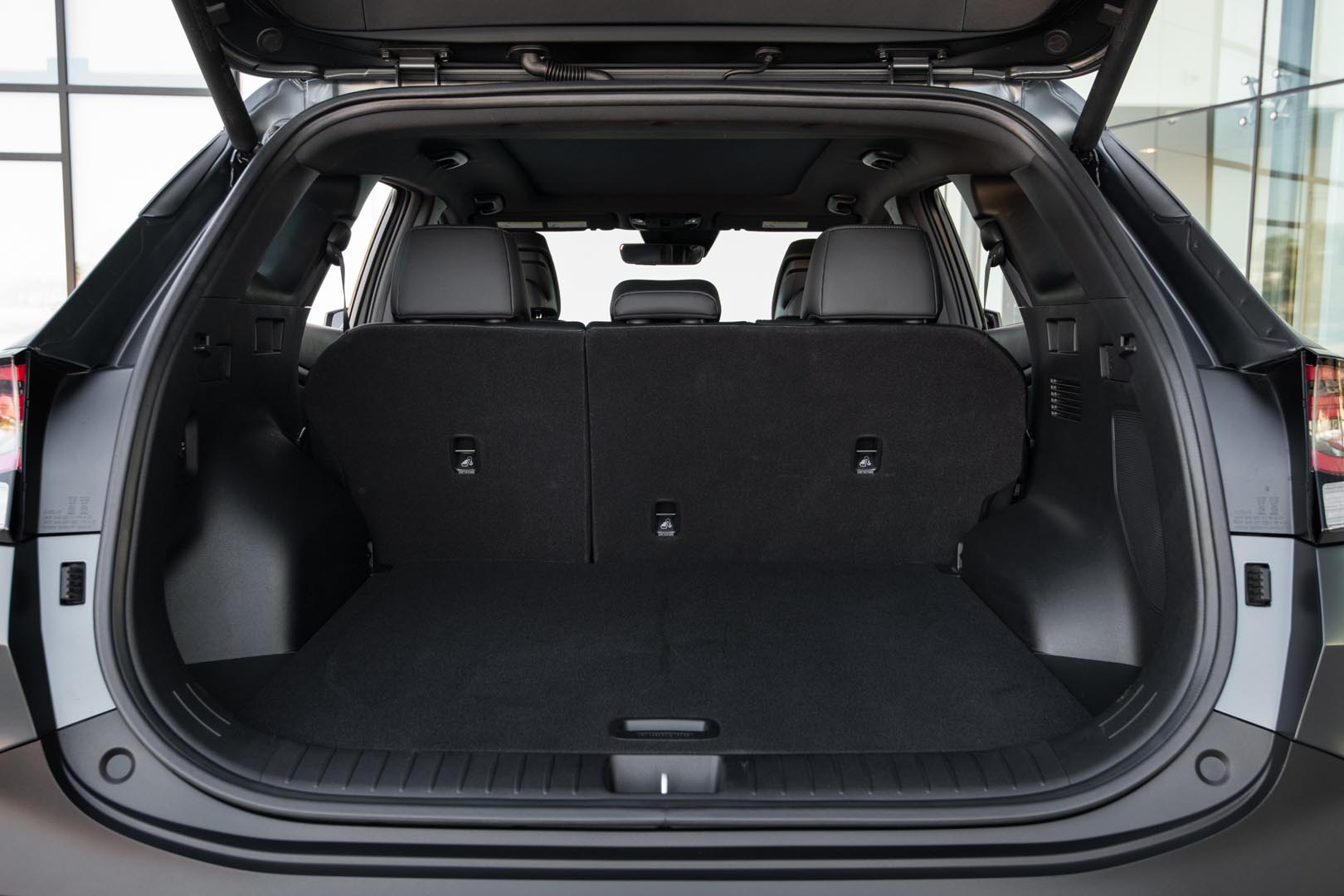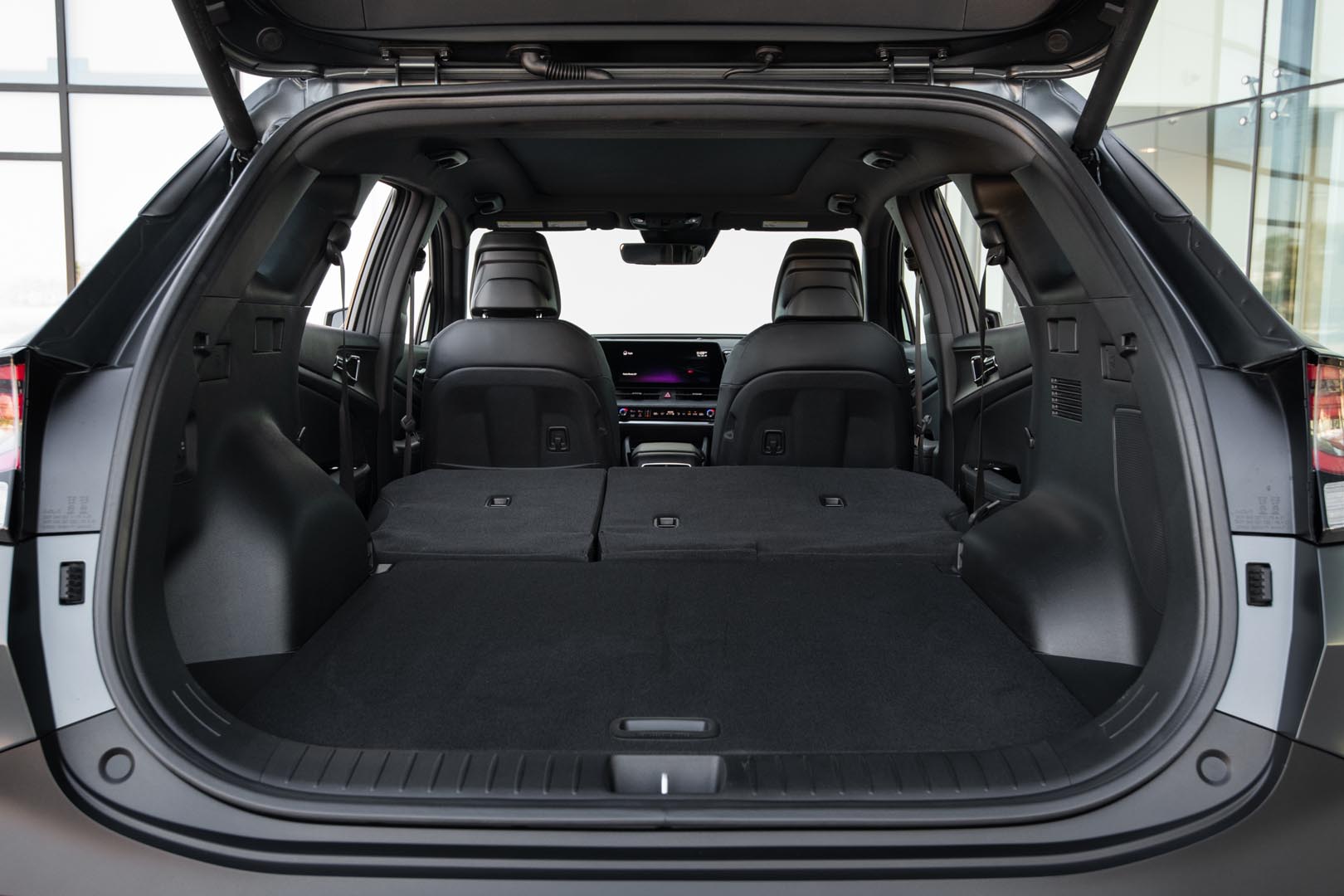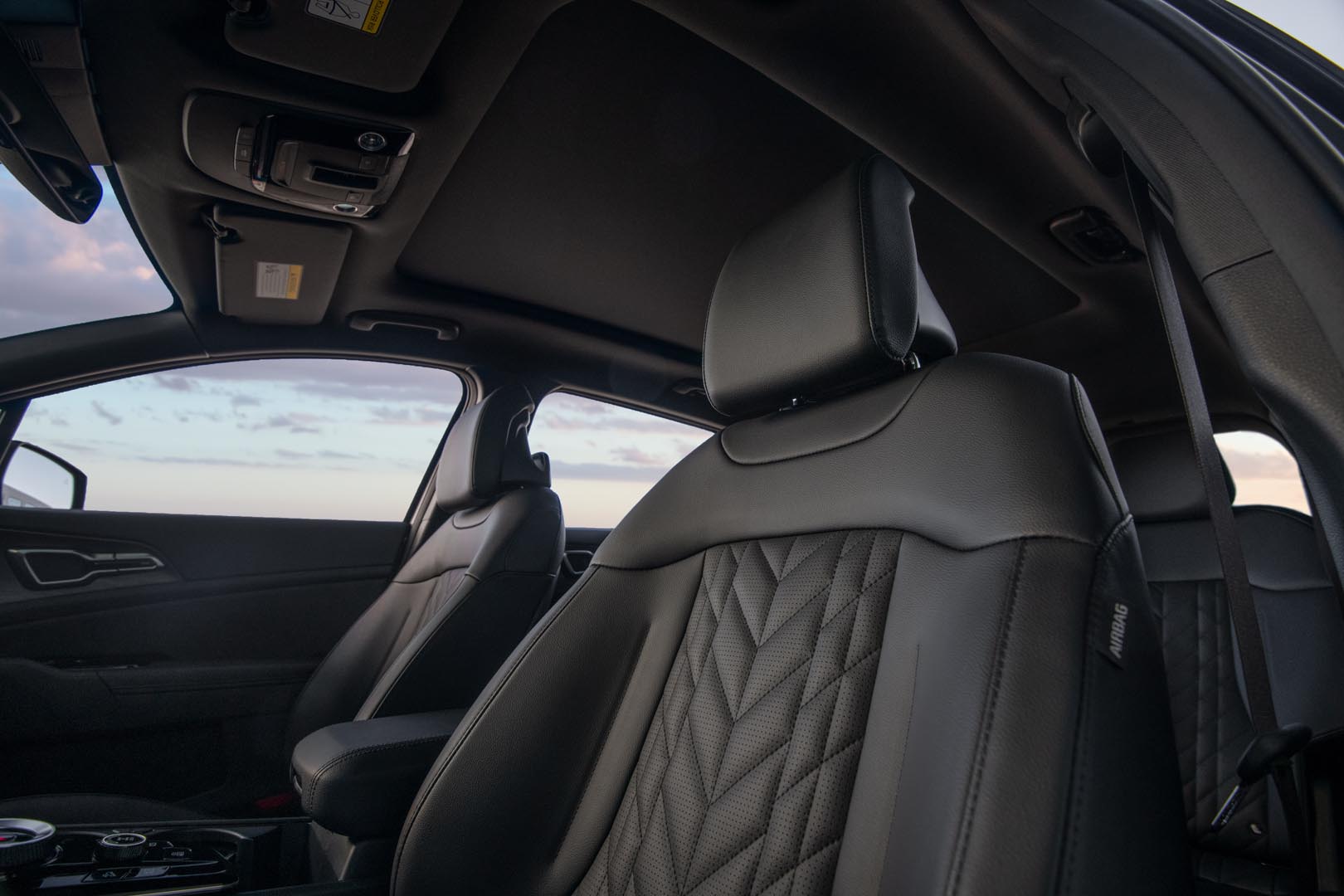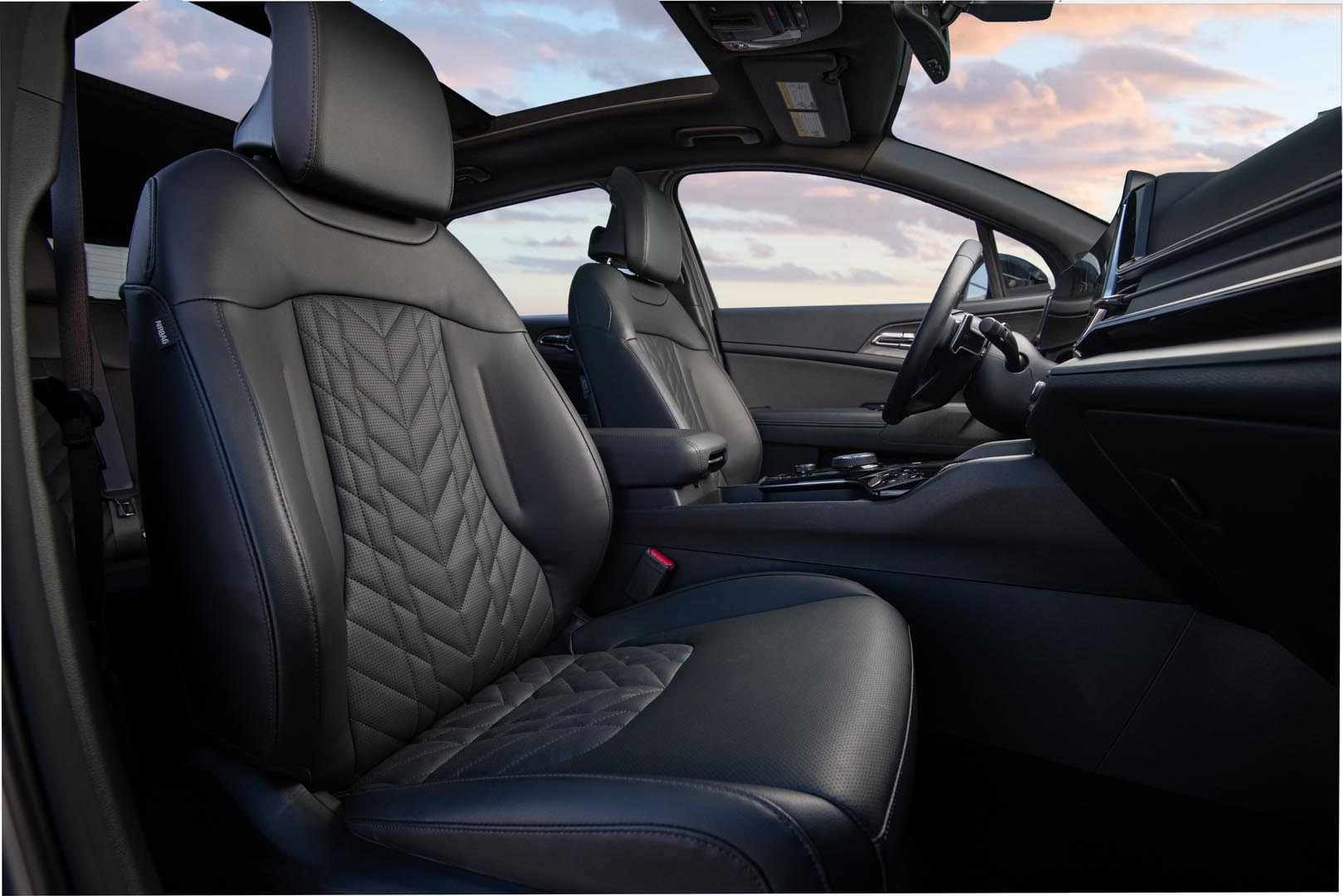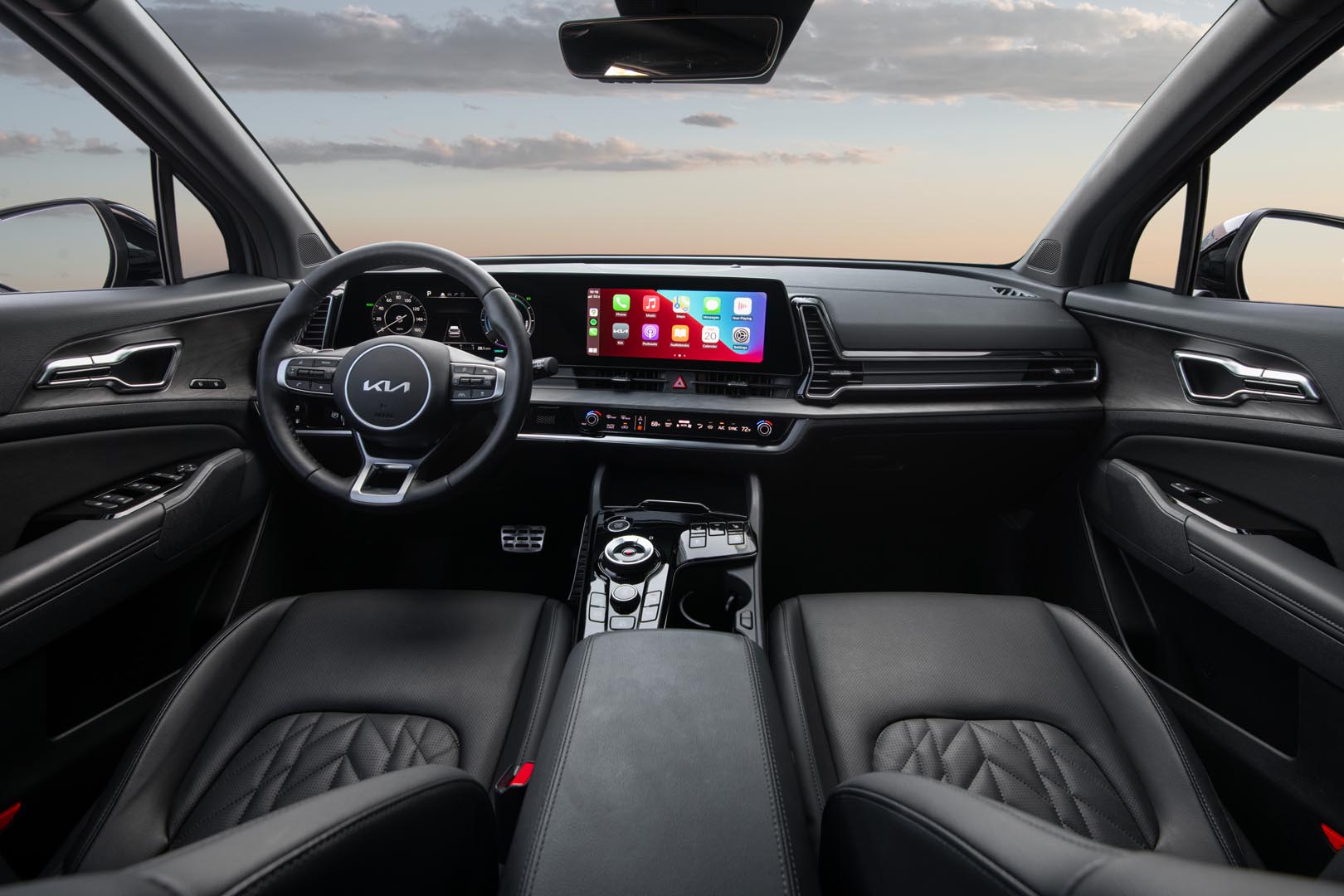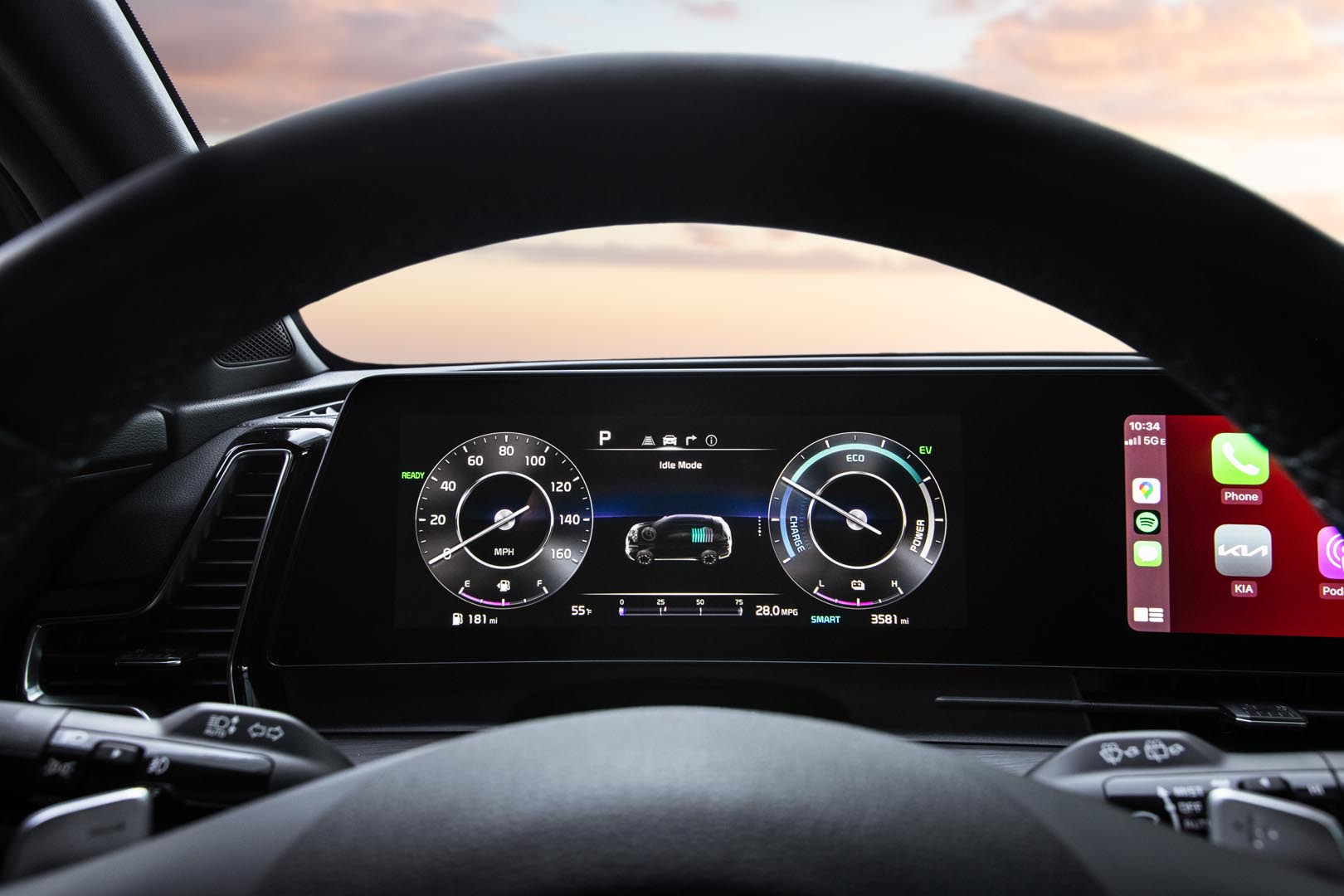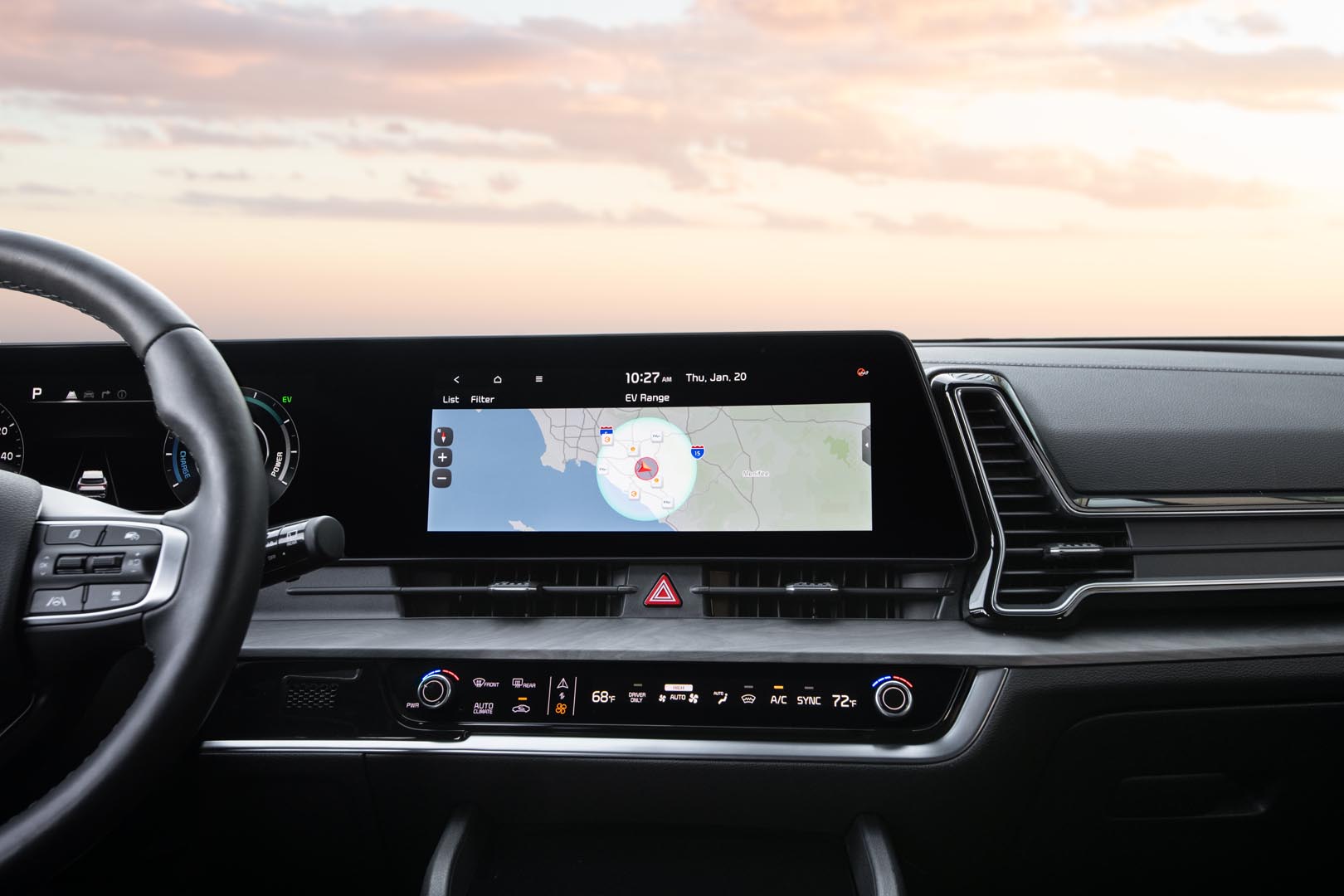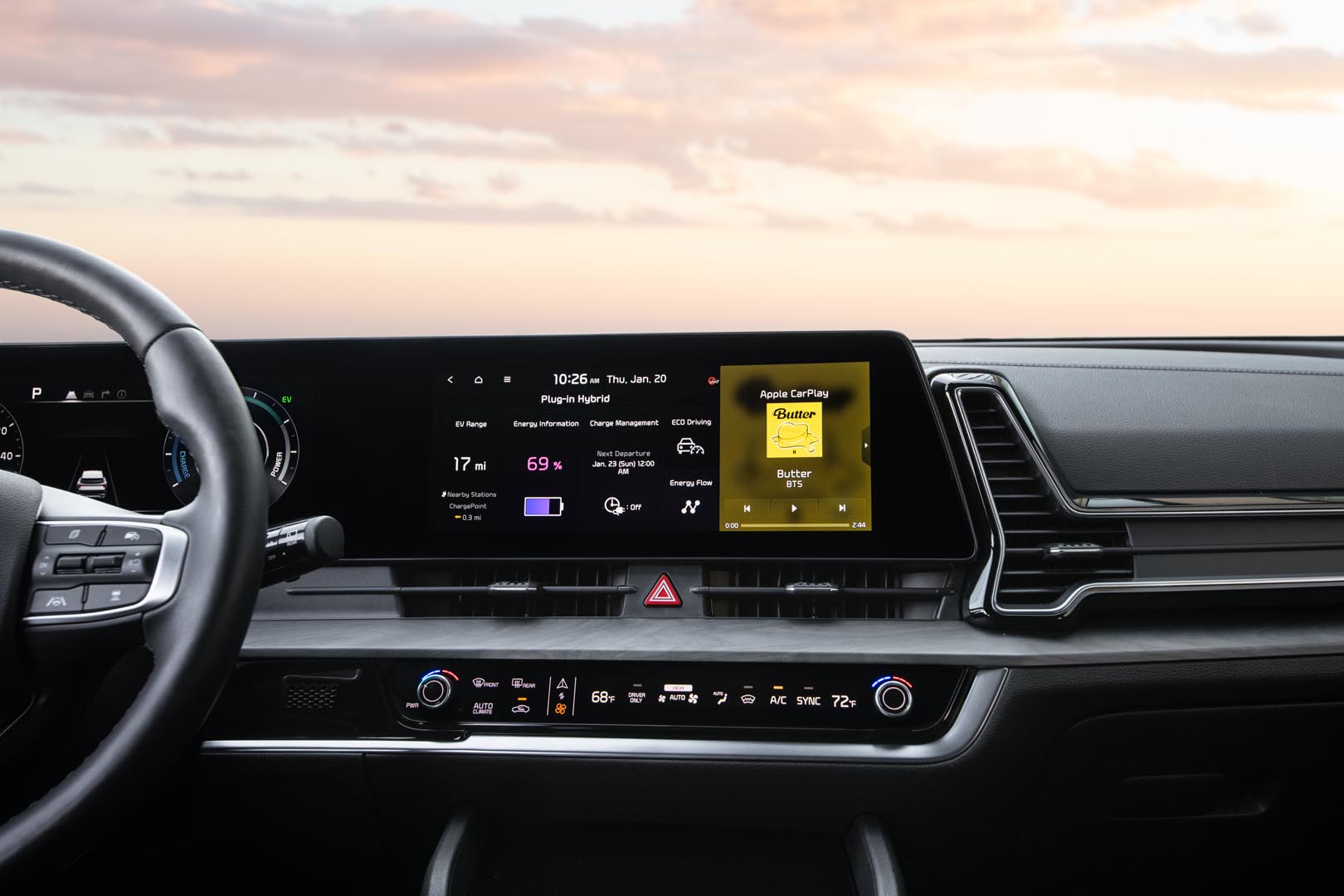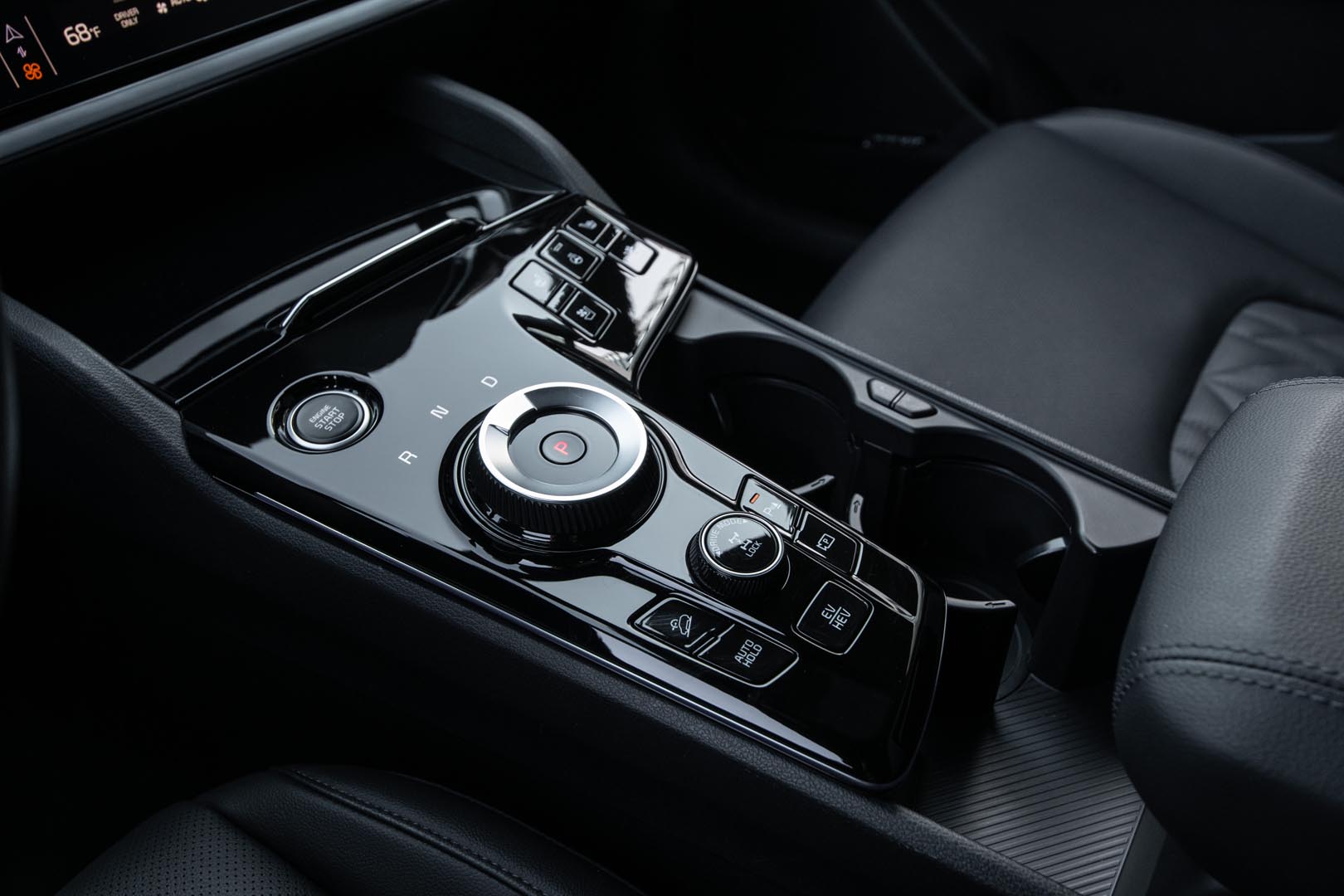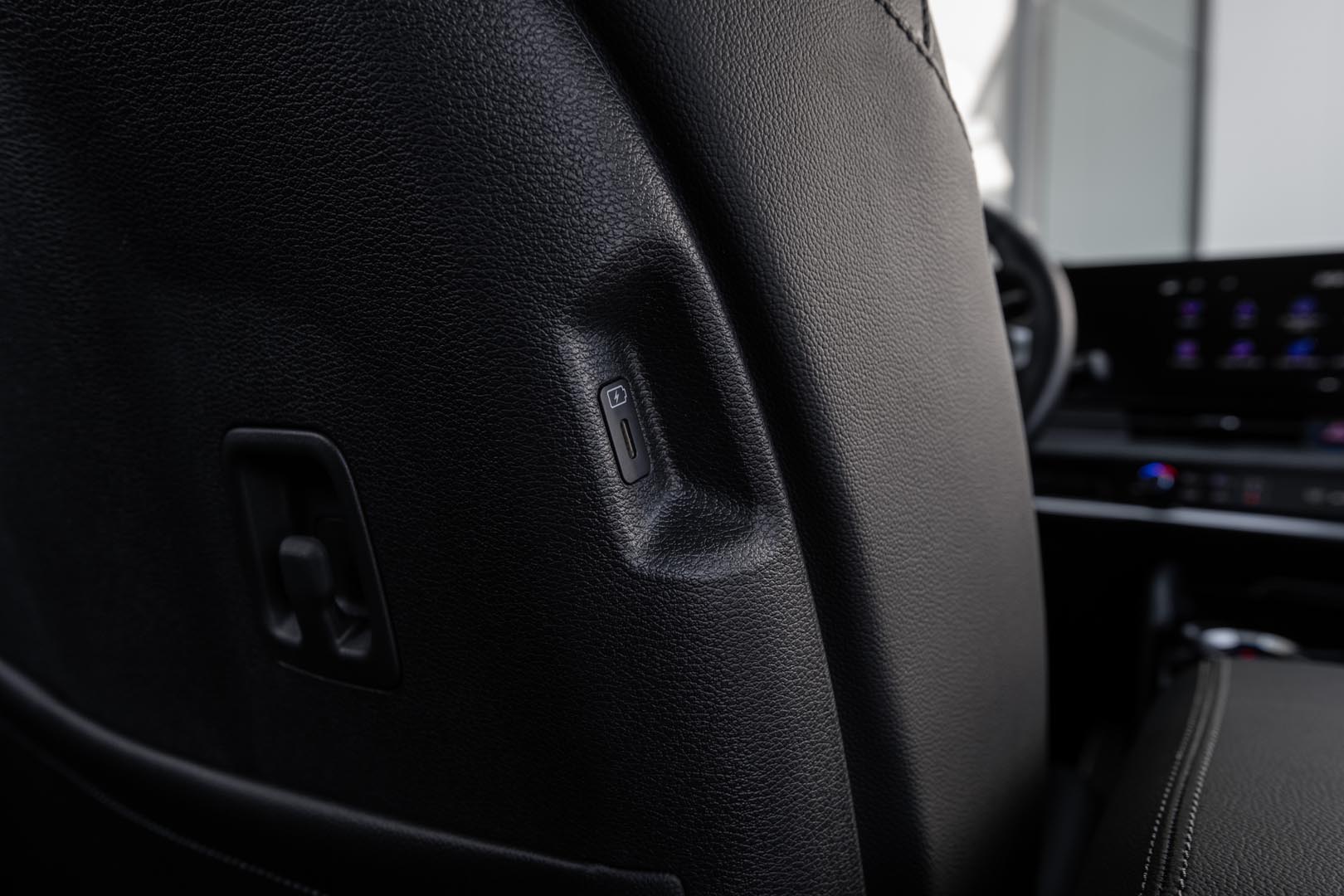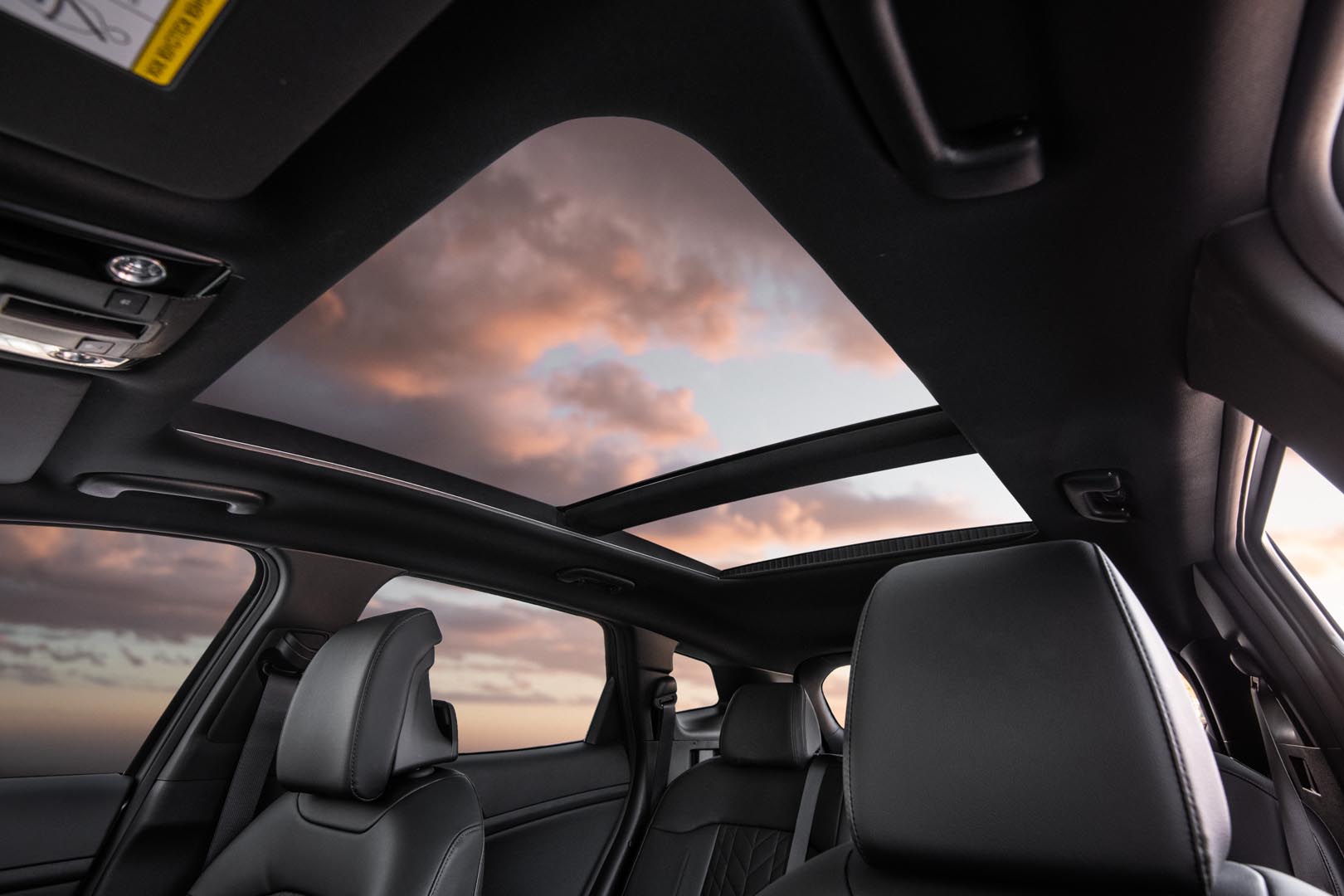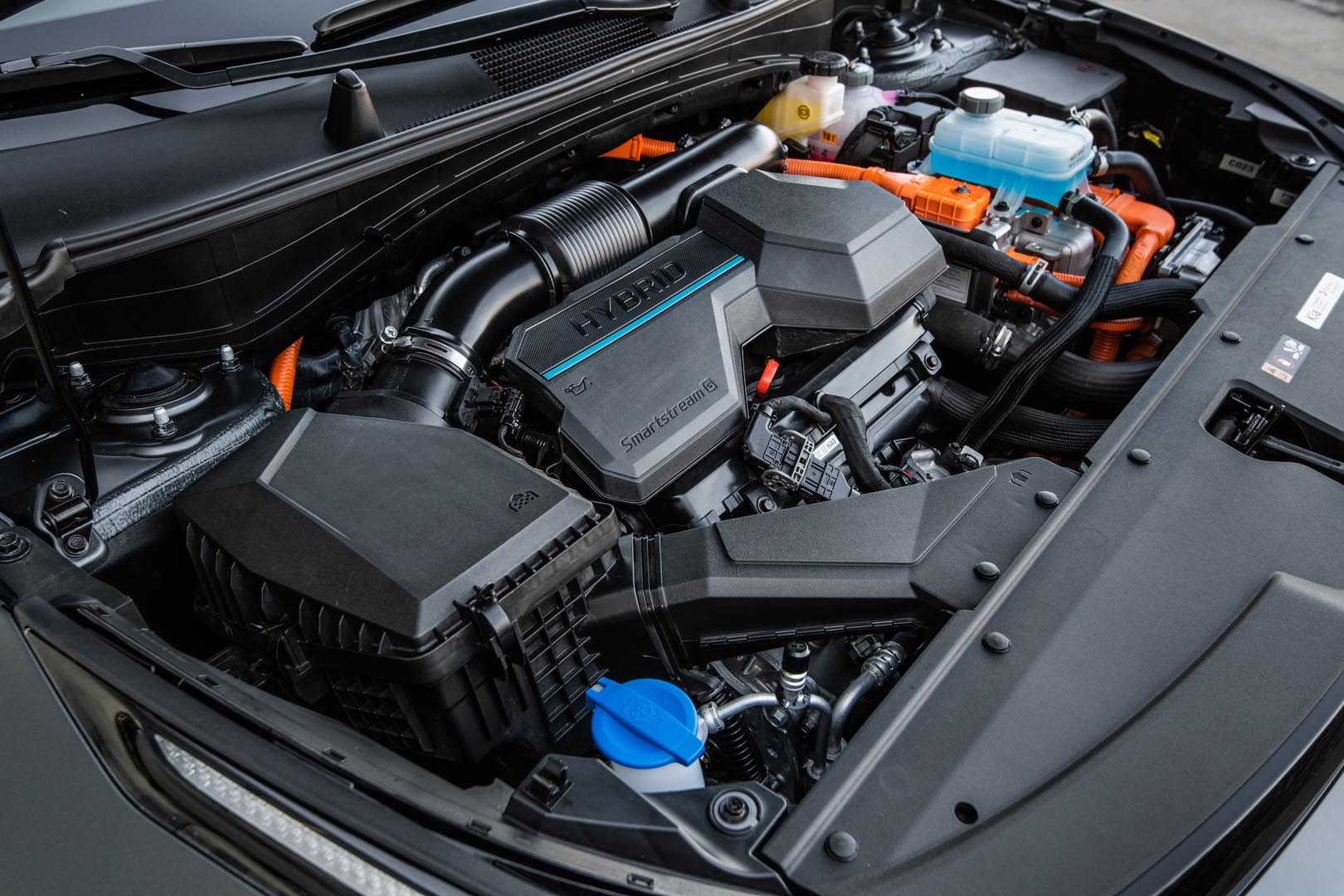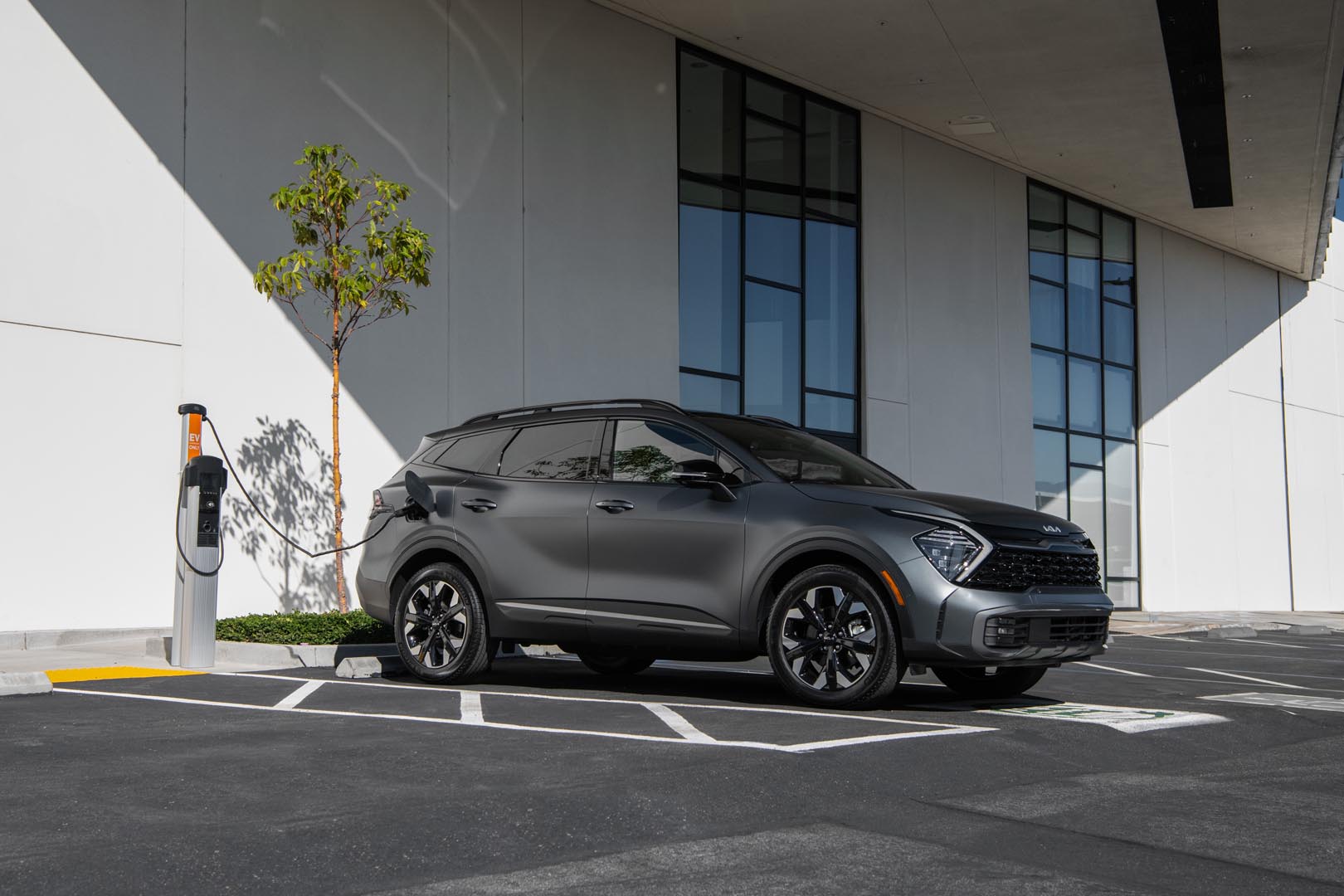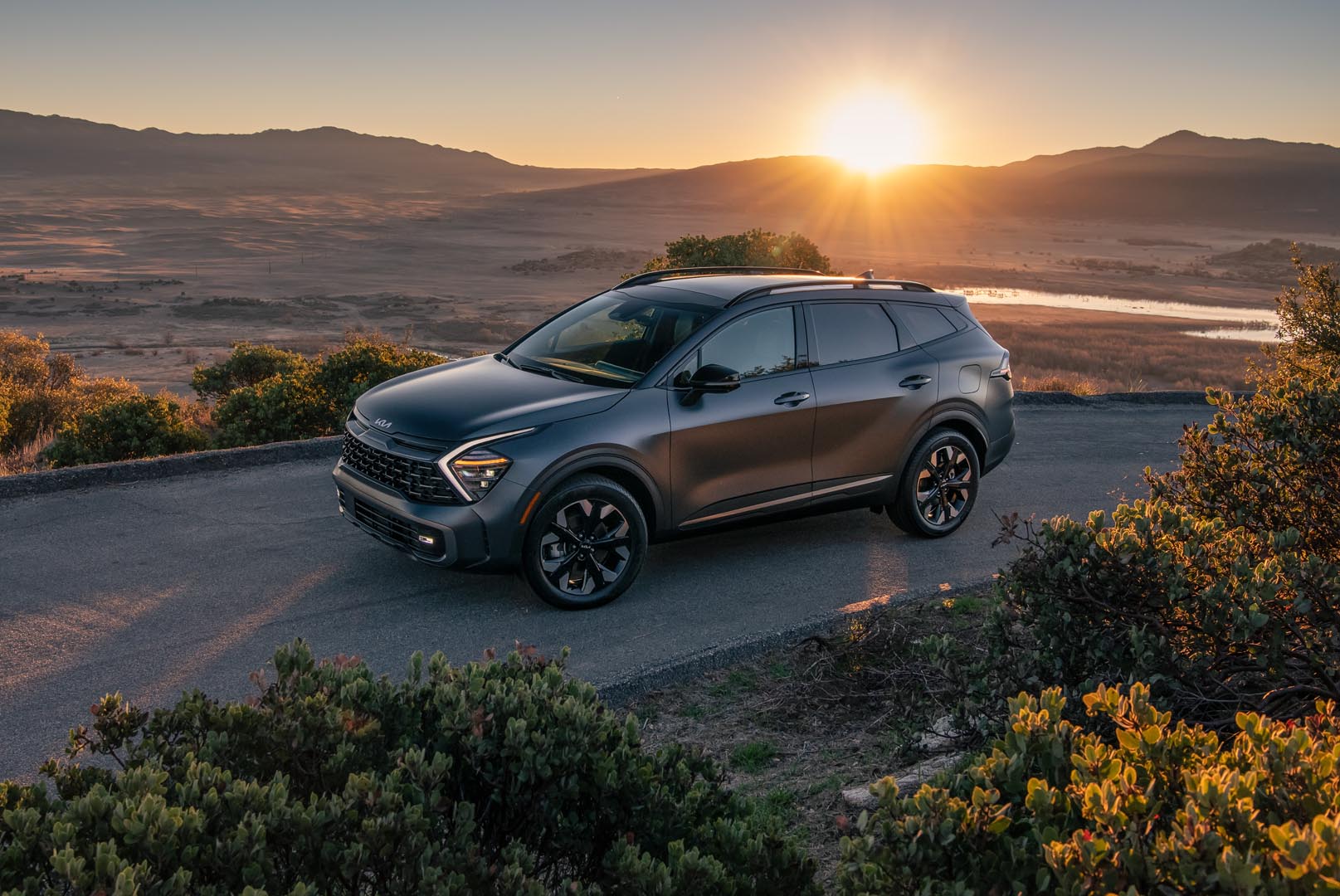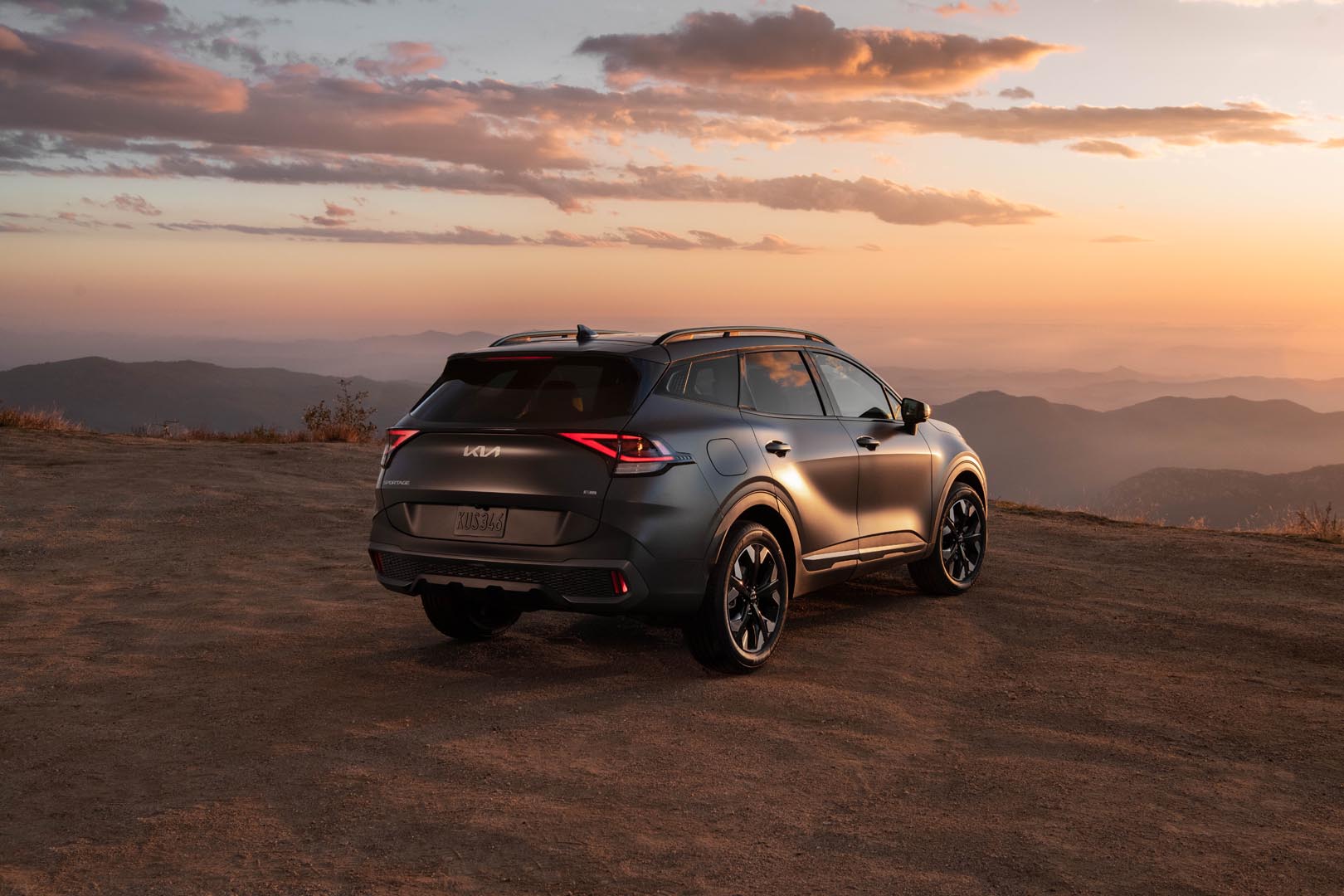
KIA Sportage PHEV 2024
Pros and cons
Pros
- Extremely quiet ride
- Comfortable suspension
- Excellent directional stability
- Spacious, modern interior
- Significantly enlarged trunk
- Advantageous equipment-price ratio
Cons
- Easily noticeable understeer and body roll
- Hardly any electric range in winter
- Transition to gasoline engine slow at times
- Driving position too high
- Irritating dual-function controls
Overview
The fifth generation of the Sportage has been enjoying great popularity since its arrival a year ago. Its eye-catching styling and increased dimensions are no doubt part of this success, but Kia also played the electrification card to broaden its customer base. As such, it offers two hybrid versions of its compact SUV, one rechargeable, and the other not. We tested the first, which comes with all-wheel drive, an attractive equipment-to-price ratio and an electric range of 55km.
At $49,344 (including freight, preparation, and dealer fees), the Sportage PHEV EX Premium boasts one of the lowest retail prices for a compact plug-in SUV. The Ford Escape Plug-In Hybrid shaves a few hundred dollars off the price, but only offers front-wheel drive.
The Hyundai Tucson Plug-in Hybrid is available only in a high-end version, slightly less expensive than the Sportage PHEV SX, itself priced at $52,494. Both share a common mechanical layout, although curiously, the Hyundai’s electric range lags behind by 2km. All these models are eligible for government incentives of $7500, which will be deducted after taxes have been calculated.
Two other contenders stand out with an overall grant of $10,000 due to their superior battery capacity. First, the Toyota RAV4 Prime, the golden child of the category, with a price ranging from $54,000 to over $64,000. Even after deducting government incentives, this Japanese vehicle still costs considerably more than any of its rivals.
On the other hand, these enhanced incentives make the Mitsubishi Outlander PHEV as competitive as the South Korean models, and this in spite of higher retail prices.
Sportage PHEVs sold in Canada are sourced either from South Korea, like our sample, or from the U.S. state of Georgia.
Verdict
Admittedly, the Sportage has lost the sporty edge that characterized its two previous iterations. However, Kia has provided it with ride comfort, roominess and a contemporary design that are far more appealing to its target customer base than dynamic prowess. On top of that, thanks to government incentives, plug-in models cost about the same price as their gas-powered equivalents … not to mention the savings at the pump and the gains in refinement they bring. If you can find a Sportage PHEV—or afford to wait a long time—you’ll definitely be getting a good deal.
Evaluation
Body, cabin and cargo space
Up until last year, the Sportage had always been one of the smallest compact SUVs on the market. This fifth generation has shattered the mould, with an 18cm increase in length over its predecessor.
There’s an immediately noticeable difference in the cabin, especially when it comes to the rear seats. Furthermore, cargo space now rivals that of a Honda CR-V, Nissan Rogue or Volkswagen Tiguan.
Already, this extra space makes the Sportage welcoming, but it goes beyond that. The meticulous finish is combined with high-quality materials; however, expect the ubiquitous piano black plastic to scratch easily.
The dashboard is a real eye-catcher, boasting a pair of horizontally juxtaposed screens. Their crystal-clear appearance is more reminiscent of a luxury vehicle than a compact SUV. Yet this layout has the drawback of shielding the top of the gauges from view. The head-up display makes up for this, but is exclusive to the SX version.
Indeed, in some respects, shape sometimes takes precedence over function. The row of buttons and dual-purpose knobs under the central display especially come to mind. The touch-sensitive controls are too small, particularly the one that toggles between the two modes. One shouldn’t have to take their eyes off the road to check whether they’re actually reducing the temperature or lowering the audio volume.
This is an irritant the Sportage shares with the Niro, as is the higher-than-average driving position, even when the seat is set low. Fortunately, headroom is still sufficient for tall people.
Safety
Safety features
- Antilock brakes with electronic brake-force distribution and brake assist
- Stability and traction control
- Hill-start assist
- Hill descent control
- Front airbags
- Driver knee airbag
- Central airbag designed to deploy between driver and passenger in the event of side impact
- Front side airbags
- Side curtain airbags
- Seat belts with pretensioners
- Five adjustable head restraints, with the front ones designed to reduce the effect of whiplash in rear impacts
- Rear-seat bench reminder available
- Backup camera
- Front and rear parking assistance sensors
- Tire pressure monitor
- Forward collision warning
- Front automatic emergency braking with detection of pedestrians, cyclists, and vehicles approaching from the opposite direction at an intersection
- Lane departure alert with automatic steering assist
- Active lane centering
- Auto high beam
- Adaptive cruise control
- Blind-spot monitoring system with automatic steering assist
- Rear cross-traffic alert with automatic braking
- Rear automatic emergency braking, blind spot display in dashboard and perimeter monitoring system (standard on SX, unavailable on EX Premium)
Crash test results
National Highway Traffic Safety Administration
Overall score: Not tested
Frontal impact: 5 / 5
Side impact: Not tested
Rollover resistance: 4 / 5
Insurance Institute For Highway Safety
Moderate overlap frontal impact: 4 / 4
Small overlap frontal impact: 4 / 4
Side impact: 4 / 4
Rear impact: Not tested
Roof strength: Not tested
IIHS Top Safety Pick
Visibility
Visibility is unimpeded toward the front, thanks to reasonably narrow A-pillars and a small triangular window in front of the rearview mirrors. However, visibility is poor toward the rear and sides, owing to the steep sill of the mirrors. Blind-spot monitoring lends a helping hand when changing lanes. The SX version adds a further layer of protection by displaying blind spots on the instrumentation screen when the turn signal is activated, albeit the cameras get dirty before you know it in winter.
Headlights: LED headlights scored 3 out of 4 in the Insurance Institute for Highway Safety evaluation. Illuminated distance is generally good, except when making long radius turns to the left in low-beam mode, and on the same side of a straight line in high-beam mode.
Mechanical overview
The Hyundai group didn’t have to look far to engineer the plug-in hybrid powertrain for its compact (Hyundai Tucson and Kia Sportage) and midsize (Hyundai Santa Fe and Kia Sorento) crossovers. It simply paired its 1.6-litre turbocharged four-cylinder engine, already in use in several models since 2012, with an electric motor and a 13.8-kilowatt-hour lithium-ion polymer battery.
The whole package delivers 261hp and 258 lb-ft of torque, thus making the Sportage PHEV the most powerful in the line-up. There’s also a non-plug-in hybrid version that boasts the same torque as the plug-in, albeit with a maximum output of 227hp.
In both cases, a conventional automatic transmission with six gears—rather than eight in the non-electrified Sportage—relays torque to all four wheels. Unlike Mitsubishi and Toyota, whose separate electric motors power the rear axle, Hyundai and Kia use a conventional all-wheel-drive system complete with a driveshaft. Up to half the torque is distributed to the rear in case of loss of grip, tight cornering or strong acceleration. The vehicle behaves like an front-wheel-drive model in normal driving conditions.
Natural Resources Canada (NR Can) reports an electric range of 55km, ranking the Sportage PHEV behind the Escape plug-in hybrid (60km), Outlander PHEV (61km), and RAV4 Prime (68km). Strangely, the plug-in Tucson achieves 2km less than its cousin, despite identical mechanical components. Charging time from 15% to 100% capacity takes 2 hours on a 240-volt station and over 11 hours on a standard 120-volt outlet. You can expect a slightly longer charge time in winter if you use the latter option.
When the battery is running low, the vehicle operates like a conventional hybrid, relying primarily on the gasoline engine. Even with a full battery, the latter often runs at around 1,200rpm constantly in winter, so as to help warm up the cabin. Therefore, our winter test only allowed us to drive in 100% electric mode for a few sets of 4 or 5km at cruising speed. Mark our words: it’s especially in mild weather and during summer that a plug-in hybrid can help you save money on your energy bill.
For instance, on a 45km highway drive at -14°C, only 18km was deducted from the electric range displayed at 52km with a fully charged battery. At -4°C, the electric range ran out after 48km, but the gasoline engine still required 2.5L/100km to power the heater.
We recorded an overall fuel consumption of 7.7L/100km at the end of our 811km test drive, of which approximately 150km was covered in electric mode. Natural Resources Canada reports a city-highway average of 6.7L/100km in conventional hybrid mode.
Driving impressions
Both previous generations of the Sportage had a leaning toward driving which, if not sporty, was at least dynamic. The trade-off was that they subjected their passengers to a somewhat stiff, choppy ride.
The latest version changes the whole picture. This time around, comfort seems to have been Kia’s top priority, with a suspension that copes quite well with bumps and holes. The Sportage now proves very stable in a straight line, and its body waddles less from left to right on bumpy roads. The weight of the battery under the floor of the PHEV version and the longer wheelbase partly account for this new serenity.
Another highlight of refinement is the enhanced soundproofing, which muffles tire noise much better than before. We were also impressed by the quietness of the gasoline engine: in comparison with the Toyota RAV4 we drove the same week, the difference was striking.
In electric mode, there’s enough power to reach highway speeds without the gas engine kicking in, provided the need for heating hasn’t already caused it to kick in. Performance is more than satisfactory when the two engines work in combination, although the 261hp promised are not quite felt.
On the downside, the gas engine can sometimes take up to a second to engage when moving off from a stop in hybrid mode. A feature found in all recent hybrid models from the Hyundai group, whether plug-in or not, this phenomenon can create a certain amount of anxiety when it comes to quickly pulling out of the lane.
Also worth mentioning is the high body lean and low grip limit when taking a corner with a bit of enthusiasm. Naturally, you wouldn’t buy a Sportage to be a race car driver, but many competitors demonstrate greater aplomb.
Finally, the traditional all-wheel-drive system lacks the finesse and speed of the Mitsubishi Outlander PHEV or the electrified Toyota RAV4. The latter entrust management of the rear axle to an electric motor, without any mechanical link to the front end. You’ll have no trouble squeezing out of a snowbank in a Sportage PHEV, but driving on snow-covered or icy roads won’t be as smooth as that of its rivals.
Other highlights
Braking: imperceptible transition from regenerative braking to mechanical braking. Pedal easy to modulate and more natural than that of an Outlander PHEV, for example. Unlike the latter and other 100% electric Hyundai/Kia models, the Sportage PHEV does not feature single-pedal driving.
Driving assistance: fairly well-calibrated adaptive cruise control. Unfortunately, the latest-generation Kia models—including the high-end versions of the redesigned Sorento—no longer offer the option of using conventional cruise control. In addition, the lane-following system engages automatically with the adaptive cruise control. Therefore, despite its effectiveness, it must be disabled if full control over driving is to be maintained.
